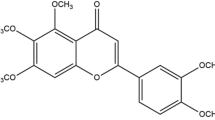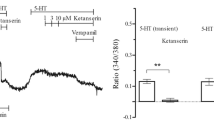Abstract
Derived from the estrane progestins, mifepristone was the first synthetic steroid of this class employed as abortifacient in the first months of pregnancy. Mifepristone reduces high potassium-induced contraction and prevents calcium-induced contraction. At the vascular level, mifepristone induces direct relaxation in rat and human arteries, and this effect seems to be endothelium- and NO independent, suggesting that the vascular smooth muscle is its target. Moreover, mifepristone’s effect could involve the modulation of different calcium channels. The aim of the present study is to analyze the involvement of calcium channels in the relaxation induced by mifepristone on vascular smooth muscle cells (VSMCs). Planar cell surface area (PCSA) technique was used to analyze the effect of mifepristone on the VSMC contractility, and the whole cell configuration of patch-clamp technique to measure the activity of L-type Ca2+ channels (LTCC) in A7r5 cells. Regarding the PCSA technique, mifepristone induced relaxation of the VSMC previously contracted by different agents. Also, a rapid inhibitory effect on basal and BAY K8644-stimulated calcium current was observed, which indicates that this drug has the ability to block LTCC. These results suggest that mifepristone induces relaxation on the VSMCs due to the inhibition of the calcium channels.
Similar content being viewed by others
References
Gagne D, Pons M, Philibert D. RU 38486: a potent antiglucocorticoid in vitro and in vivo. J Steroid Biochem. 1985;23(3): 247–251.
Spitz IM, Robbins A. Mechanism of action and clinical effects of antiprogestins on the non-pregnant uterus. Hum Reprod Update. 1998;4(5):584–593.
Schaff EA. Mifepristone: ten years later. Contraception. 2010; 81(1):1–7.
Perusquia M, Espinoza J, Navarrete E. Nongenomic uterine relaxing effect of RU 486 (mifepristone) prior to its antiprogesterone activity in the human pregnancy. Steroids. 2009;74(10–11): 825–831.
Bygdeman M, Swahn ML. Termination of early pregnancy with antiprogestin and prostaglandin. Lakartidningen. 1988;85(47): 4040–4041.
Sitruk-Ware R. Mifepristone and misoprostol sequential regimen side effects, complications and safety. Contraception. 2006;74(1): 48–55.
Perusquia M, Espinoza J, de la Pena A. Mifepristone (RU 486) induces vasodilation and inhibits platelet aggregation: nongenomic and genomic action to cause hemorrhage. Contraception. 2011;84(2):169–177.
Sitruk-Ware R, Spitz IM. Pharmacological properties of mifepristone: toxicology and safety in animal and human studies. Contraception. 2003;68(6):409–420.
Haluska GJ, Stanczyk FZ, Cook MJ, Novy MJ. Temporal changes in uterine activity and prostaglandin response to RU486 in rhesus macaques in late gestation. Am J Obstet Gynecol. 1987;157(6): 1487–1495.
Wolf JP, Sinosich M, Anderson TL, Ulmann A, Baulieu EE, Hodgen GD. Progesterone antagonist (RU 486) for cervical dilation, labor induction, and delivery in monkeys: effectiveness in combination with oxytocin. Am J Obstet Gynecol. 1989;160(1):45–47.
Perusquia M, Kubli-Garfias C. Progesterone-like relaxant effect of RU 486 in the rat myometrium. Life Sci. 1994;54(20): 1501–1506.
Cairrao E, Alvarez E, Carvas JM, Santos-Silva AJ, Verde I. Non-genomic vasorelaxant effects of 17beta-estradiol and progesterone in rat aorta are mediated by L-type Ca2+ current inhibition. Acta Pharmacologica Sinica. 2012;33(5):615–624.
van Borren MM, Verkerk AO, Vanharanta SK, Baartscheer A, Coronel R, Ravesloot JH. Reduced swelling-activated Cl(-) current densities in hypertrophied ventricular myocytes of rabbits with heart failure. Cardiovasc Res. 2002;53(4):869–878.
Peiro C, Angulo J, Rodriguez-Manas L, et al. Vascular smooth muscle cell hypertrophy induced by glycosylated human oxyhaemoglobin. Br J Pharmacol. 1998;125(4):637–644.
Hamill OP, Marty A, Neher E, Sakmann B, Sigworth FJ. Improved patch-clamp techniques for high-resolution current recording from cells and cell-free membrane patches. Pflugers Arch. 1981;391(2):85–100.
Cairrao E, Alvarez E, Santos-Silva AJ, Verde I. Potassium channels are involved in testosterone-induced vasorelaxation of human umbilical artery. Naunyn Schmiedebergs Arch Pharmacol. 2008;376(5):375–383.
Edwards DP. Regulation of signal transduction pathways by estrogen and progesterone. Annu Rev Physiol. 2005;67: 335–376.
Feiteiro J, Santos-Silva AJ, Verde I, Cairrao E. Testosterone and atrial natriuretic Peptide share the same pathway to induce vasorelaxation of human umbilical artery. J Cardiovasc Pharmacol. 2014;63(5):461–465.
Gutierrez M, Martinez V, Cantabrana B, Hidalgo A. Genomic and non-genomic effects of steroidal drugs on smooth muscle contraction in vitro. Life Sci. 1994;55(6):437–443.
Perusquia M, Garcia-Yanez E, Ibanez R, Kubli-Garfias C. Non-genomic mechanism of action of delta-4 and 5-reduced androgens and progestins on the contractility of the isolated rat myometrium. Life Sci. 1990;47(17):1547–1553.
Sanchez Aparicio JA, Gutierrez M, Hidalgo A, Cantabrana B. Effects of androgens on isolated rat uterus. Life Sci. 1993;53(3): 269–274.
Scragg JL, Dallas ML, Peers C. Molecular requirements for L-type Ca2+ channel blockade by testosterone. Cell Calcium. 2007;42(1):11–15.
Fernandez AI, Martinez V, Cantabrana B, Hidalgo A. Differential effect of calcium and Bay K 8644 on the inhibitory action of estrogens in the rat uterus. Gen Pharmacol. 1992;23(3):549–554.
Goyache FM, Gutierrez M, Hidalgo A, Cantabrana B. Non-genomic effects of catecholestrogens in the in vitro rat uterine contraction. Gen Pharmacol. 1995;26(1):219–223.
Salas E, Lopez MG, Villarroya M, et al. Endothelium-independent relaxation by 17-alpha-estradiol of pig coronary arteries. Eur J Pharmacol. 1994;258(1–2):47–55.
McEwen BS. Non-genomic and genomic effects of steroids on neural activity. Trends Pharmacol Sci. 1991;12(4):141–147.
Moss RL, Dudley CA. Molecular aspects of the interaction between estrogen and the membrane excitability of hypothalamic nerve cells. Prog Brain Res. 1984;61:3–22.
Parra J, Cantabrana B, Hidalgo A. Mechanism of mifepristone-induced spasmolytic effect on isolated rat uterus. Life Sci. 2000; 66(26):2563–2569.
Schumacher M. Rapid membrane effects of steroid hormones: an emerging concept in neuroendocrinology. Trends Neurosci. 1990; 13(9):359–362.
Santos-Silva AJ, Cairrao E, Marques B, Verde I. Regulation of human umbilical artery contractility by different serotonin and histamine receptors. Reprod Sci. 2009;16(12):1175–1185.
Kaumann AJ, Levy FO. 5-hydroxytryptamine receptors in the human cardiovascular system. Pharmacol Ther. 2006;111(3): 674–706.
Guimaraes S, Moura D. Vascular adrenoceptors: an update. Pharmacol Rev. 2001;53(2):319–356.
Wang Y, Hou R, Li P, et al. Gene expression profiles in response to the activation of adrenoceptors in A7r5 aortic smooth muscle cells. Clin Exp Pharmacol Physiol. 2004;31(9):602–607.
Traupe T, Stettler CD, Li H, et al. Distinct roles of estrogen receptors alpha and beta mediating acute vasodilation of epicardial coronary arteries. Hypertension. 2007;49(6):1364–1370.
Weihua Z, Saji S, Makinen S, et al. Estrogen receptor (ER) beta, a modulator of ERalpha in the uterus. Proc Natl Acad Sci USA. 2000;97(11):5936–5941.
Perusquia M, Hernandez R, Morales MA, Campos MG, Villalon CM. Role of endothelium in the vasodilating effect of progestins and androgens on the rat thoracic aorta. Gen Pharmacol. 1996; 27(1):181–185.
Stull JT, Gallagher PJ, Herring BP, Kamm KE. Vascular smooth muscle contractile elements. Cellular regulation. Hypertension. 1991;17(16 pt 1):723–732.
Cairrao E, Carvas J, Santos-Silva AJ, Alvarez E, Verde I. 17beta-Estradiol and progesterone inhibit L-type Ca2+ current of rat aorta smooth muscle cells. Portugaliae Electrochimica Acta. 2006;24(2):241–255.
Zhang F, Ram JL, Standley PR, Sowers JR. 17 beta-Estradiol attenuates voltage-dependent Ca2+ currents in A7r5 vascular smooth muscle cell line. Am J Physiol. 1994;266(4 pt 1): c975–c980.
Zhang M, Benishin CG, Pang PK. Rapid inhibition of the contraction of rat tail artery by progesterone is mediated by inhibition of calcium currents. J Pharm Pharmacol. 2002;54(12):1667–1674.
Nakajima T, Kitazawa T, Hamada E, Hazama H, Omata M, Kurachi Y. 17beta-Estradiol inhibits the voltage-dependent L-type Ca2+ currents in aortic smooth muscle cells. Eur J Pharmacol. 1995;294(2–3):625–635.
Cairrão E, Santos-Silva AJ, Verde I. PKG is involved in testosterone-induced vasorelaxation of human umbilical artery. Eur J Pharmacol. 2010;640(1–3):94–101.
Montano LM, Calixto E, Figueroa A, Flores-Soto E, Carbajal V, Perusquia M. Relaxation of androgens on rat thoracic aorta: testosterone concentration dependent agonist/antagonist L-type Ca2+ channel activity, and 5{beta}-dihydrotestosterone restricted to L-type Ca2+ channel antagonism. Endocrinology. 2008; 149(5): 2517–2526.
Deenadayalu V, Puttabyatappa Y, Liu AT, Stallone JN, White RE. Testosterone-induced relaxation of coronary arteries: activation of BKCa channels via the cGMP-dependent protein kinase. Am J Physiol Heart Circ Physiol. 2012;302(1):h115–h123. 45. Keung W, Vanhoutte PM, Man RY. Acute impairment of contractile responses by 17beta-estradiol is cAMP and protein kinase G dependent in vascular smooth muscle cells of the porcine coronary arteries. Br J Pharmacol. 2005;144(1):71–79.
Mugge A, Riedel M, Barton M, Kuhn M, Lichtlen PR. Endothelium independent relaxation of human coronary arteries by 17 beta-oestradiol in vitro. Cardiovasc Res. 1993;27(11): 1939–1942.
Perusquia M. Nongenomic action of steroids in myometrial contractility. Endocrine. 2001;15(1):63–72.
Perusquia M. Nongenomic action of steroids in myometrial contractility. Endocrine. 2001;15(1):63–72.
Author information
Authors and Affiliations
Corresponding author
Rights and permissions
About this article
Cite this article
Mariana, M., Feiteiro, J., Cairrao, E. et al. Mifepristone is a Vasodilator Due to the Inhibition of Smooth Muscle Cells L-Type Ca2+ Channels. Reprod. Sci. 23, 723–730 (2016). https://doi.org/10.1177/1933719115612926
Published:
Issue Date:
DOI: https://doi.org/10.1177/1933719115612926




